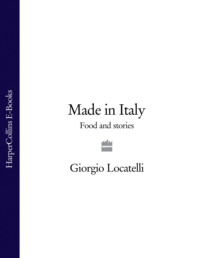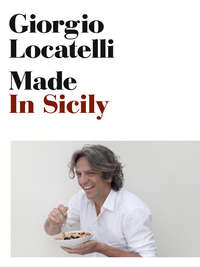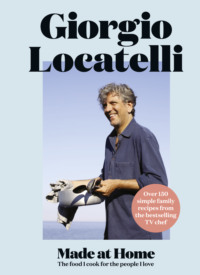
Полная версия
Made at Home: The food I cook for the people I love



Copyright

4th Estate
An imprint of HarperCollinsPublishers 1 London Bridge Street London SE1 9GF www.4thestate.co.uk
This eBook edition published by 4th Estate in 2017
Copyright text © Giorgio Locatelli 2017
All photographs © Lisa Linder 2017
Design and art direction: BLOK
www.blokdesign.co.uk
Giorgio Locatelli asserts the moral right to be identified as the author of this work.
A catalogue record for this book is available from the British Library.
All rights reserved under International and Pan-American Copyright Conventions. By payment of the required fees, you have been granted the non-exclusive, non-transferable right to access and read the text of this eBook on-screen. No part of this text may be reproduced, transmitted, downloaded, decompiled, reverse engineered, or stored in or introduced into any information storage and retrieval system, in any form or by any means, whether electronic or mechanical, now known or hereinafter invented, without the express written permission of HarperCollins Publishers.
Source ISBN: 9780008100513
Ebook Edition © September 2017 ISBN: 9780008100520
Version: 2017-08-18
For Plaxy
Contents
Cover
Title Page
Copyright
Dedication
The places I call home
Seasonal salads and vegetables
Simple soups
Panini, crostini, pies and other snacks
Pasta, rice and pizza
Favourite fish and seafood
Grilled meats, roasts and stews
Cakes, treats and ice creams
Index
Acknowledgements
About the Publisher
The places I call home
Home means many things to me. Home is north London with my wife, Plaxy, and now grown-up ‘kids’, Jack and Margherita, who come and go but still expect to raid the fridge as soon as they walk through the door. When Plaxy and I are at home on our own, the meals we share are about simply cooked fish, vegetables and salads, and many of our favourite recipes are included here. But when Margherita was small, much of our cooking had to begin with something that she could eat, since shortly after she was born we discovered that she had an allergy to around 600 foods, especially fish, tomatoes and eggs. So for years we could never have fish or tomatoes in the kitchen, and ingredients like almonds would be kept in jars in separate labelled cupboards to keep her safe. We never wanted her to feel different, so we would always find a way of making something for her that looked like what everyone else was eating, even if the ingredients varied. But for me, that should always be at the heart of all home cooking: the idea that you adapt and change according to what you buy fresh that is in season, what you have in your cupboard and your fridge, and who you are cooking for.
Home, for me, is also Corgeno in Lombardy, northern Italy, where my whole family was involved with my uncle’s restaurant, La Cinzianella, on the shore of Lake Comabbio, so my grandmother was in charge of the cooking in our house while my grandfather raised rabbits and chickens and grew vegetables in the garden. Many of the meals that my grandmother cooked, I still cook at home for my own family, and when I do, it is as if I am back in Corgeno with her and my grandad again.
According to the day of the week, we might have risotto with saffron, pasta with homemade passata, fish from the lake, and once a week fresh prawns; or stews, such as osso buco or my favourite, spezzatino, made with beef, potatoes and peas, according to whatever pieces of meat Stefanino, the village butcher, had kept for my grandmother.
When my elder brother, Roberto, and I would come home from school there would often be a soup made with my grandmother’s broth and maybe a scallopine to follow: a sliver of pork, veal or chicken, encrusted in breadcrumbs from the big jar in the kitchen and fried. I still think that in a family environment, soup is very important. It is a great comfort food; it doesn’t need so much planning, and you can make a potful and freeze some in a container for next time. If I get home late from the restaurant, or from filming, having tasted so many dishes during the course of the day, all I want is a simple soup to soothe and settle the stomach. Or a simple pasta.
I never tire of a plate of spaghetti with a brilliant tomato sauce, but I often think that while the great advantage of pasta is its familiarity, that is also its worst enemy, because we all have our one or two favourite recipes that we make over and over again, when actually a dish of pasta should reflect the changing seasons. It is a perfect medium for introducing kids to ingredients with different textures and flavours throughout the year.
My grandparents, who had been through the war, never lost the fear that there might come a day when there was no food – something that Jack and Margherita have no reason to understand – but in Europe plentiful food has come at a certain cost to society. There is no doubt that we have to address the problems of eating too much sugar and salt, the way we have made food ‘convenient’ by packing it full of additives, our wastefulness, and the fact that we cannot go on extracting so much from the earth and emitting so many gases. But one huge step is to go back to the essence of home cooking – buying fresh ingredients, preparing them simply, enjoying them with your friends and family, and keeping anything you don’t eat to transform into another meal – and that’s it.
Home, too, is my restaurant, Locanda Locatelli, where I spend most of my waking hours with my other family, the team of chefs and front of house staff, many of whom have been with me for a long, long time. You have to look after the people you work with. Ever since I sat on a rubbish bin outside the kitchen of the Tour d’Argent restaurant in Paris where I worked long, long hours for a pittance, eating sausages at the end of the night, while inside the diners paid a small fortune for the famous classic French dishes we had made for them, I vowed that when I had my own restaurant, I would make sure that everyone ate well. So each day at 4.30p.m. everyone sits down together to eat something simple that we have made in the kitchen, because that is when you have the time to talk to people, share ideas and news, find out what is going on in their lives, if someone needs help with something or has a problem. Exactly like a family sharing a meal around the table at home. The two favourite meals are ‘Italian’ burger night on Tuesday, and pizza night on Saturday, when even those who are due to finish their shifts, or on a day off, seem to find a reason to stay behind or drop by! So those recipes are included in this book, too.
And now Plaxy and I have a second home perched on the edge of a cliff overlooking the sea in Puglia, a region we discovered and fell in love with after spending so many amazing summers across the water in Sicily. In the winter, it feels like you could be on Mars, with the rocky cliff falling away beneath you, but in spring and summer the water is a stunning blue and that is all you can see.
In London, I am spoilt by so many different ingredients and cultural influences, which have pushed the way I think about food way beyond the northern Italian flavour palate that I grew up with. But on holiday everything is stripped back to a few knives and some pots and pans and whatever I find when I go out each morning – maybe with some money in my hand to meet the fishermen coming off the boats, or at the market to buy fresh local vegetables or rich, creamy burrata. So Puglia, too, has inspired some of the recipes in this book. The ingredients may be more limited, but their quality is exceptional, and that is when I feel at my most creative. I look at what I have and decide then and there how to prepare it for family and friends to share. Just as my grandmother did all those years ago in Corgeno.
Конец ознакомительного фрагмента.
Текст предоставлен ООО «ЛитРес».
Прочитайте эту книгу целиком, купив полную легальную версию на ЛитРес.
Безопасно оплатить книгу можно банковской картой Visa, MasterCard, Maestro, со счета мобильного телефона, с платежного терминала, в салоне МТС или Связной, через PayPal, WebMoney, Яндекс.Деньги, QIWI Кошелек, бонусными картами или другим удобным Вам способом.







